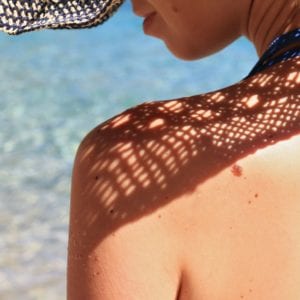Sun Damage Does Not Look the Same on Every Person’s Skin
- Posted on: Sep 15 2020
 We can always benefit from the occasional reminder that sunlight can cause serious dermatologic issues. At the very least, exposure to the ultraviolet radiation in sunlight (and tanning beds) breaks down collagen fibers in the skin. Collagen is what keeps the skin firm and plump. Collagen heals injuries, including discoloration and broken blood vessels. Without a sufficient foundation of this protein, the skin looks mottled, feels rough, and becomes paper-thin. More severe damage caused by UV light, skin cancer, poses a threat not only to appearance but to general health.
We can always benefit from the occasional reminder that sunlight can cause serious dermatologic issues. At the very least, exposure to the ultraviolet radiation in sunlight (and tanning beds) breaks down collagen fibers in the skin. Collagen is what keeps the skin firm and plump. Collagen heals injuries, including discoloration and broken blood vessels. Without a sufficient foundation of this protein, the skin looks mottled, feels rough, and becomes paper-thin. More severe damage caused by UV light, skin cancer, poses a threat not only to appearance but to general health.
Historically, we’ve been taught that sun exposure may affect certain skin tones differently than others. What we don’t equate with this insight is how sun damage shows up on the various skin tones. The Skin Cancer Foundation claims that skin tone is one of the most crucial factors in assessing the risk of sun damage and skin cancer. This foundation, as well as many dermatologists, determine risk based on the scientific classification called the Fitzpatrick skin type scale. Here, we discuss how sun damage may show up in fair, medium, and dark skin tones.
Sun Damage on Fair Skin
Skin types one and two on the Fitzpatrick scale are very fair. These skin tones have the highest risk of burning and sustaining sun damage including skin cancer. This is because lighter skin tones have less pigment (melanin) to filter UV rays. The signs of sun damage in lighter skin tones include wrinkling, persistent redness, and new freckles. If your skin is fair, it is important to be especially diligent about sunscreen use.
Sun Damage on Medium Skin
Skin types three and four on the Fitzpatrick scale are medium-toned. These skin tones tend to burn less and tan more quickly. However, there is still a risk of sun damage. A study published in Advances in Dermatology and Allergology pointed out that medium skin tones have larger melanocytes, which makes these tones somewhat prone to freckles and sunspots. Although higher levels of melanin can reduce the risk of burning to some degree, people with medium skin are still at risk for skin cancer and sun damage that causes premature aging. Because medium skin does not typically burn easily, people with a type three or four skin tone may stay in the sun longer, accruing cumulative damage that shows up years later.
Sun Damage on Dark Skin
Skin types five and six on the Fitzpatrick scale are the darkest tones. These skin tones are less susceptible to wrinkles and may have a lower risk of developing skin cancer. However, the risk is not eliminated in dark skin tones. While darker skin tones make up less than 5 percent of skin cancer cases, those that are diagnosed tend to be later stage and more concerning. Studies also suggest that darker skin tones are more susceptible to acral lentiginous melanoma, a serious form of skin cancer that can develop under the nails or on the soles of the feet or palms of the hands.
Regardless of skin tone, it is important to pay close attention to new spots or changes to existing moles or spots. Consumers who are interested in a thorough skin cancer examination and advanced skin cancer treatment options are encouraged to find a Mohs surgeon in their area. Qualified specialists can be found here. If you are a dermatologist interested in professional advancement in the area of Mohs surgery, contact us at (800) 616-2767 for more information on membership and upcoming training events.
Posted in: Skin Cancer


